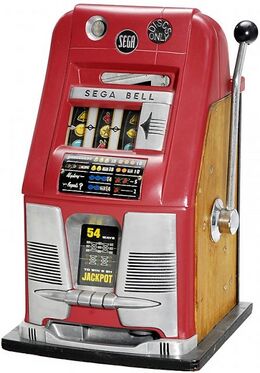Own a Piece of History With a Collectible Antique Coin Slot Machine Antique slot machines are a fun way to add amusement to your game room or living room. First invented in 1894 by Charles August Fey, many antique slot machines are available on eBay. So, I heard through forums member Donnyku that this week’s episode of the History Channel’s American Pickers featured an old Sega slot machine. “Maybe you could use the episode to get some pictures for the wiki,” he said. Like I’m going to turn down a fabulous opportunity to talk about old Sega.
Check out the game’s paytable to see the winning combos for your current game.Video slots, especially 3D slots, are the geniuses of entertaining bonus games, for they often make them bright and animated, or give them a shape of mini-games featuring video parts with storylines following the game’s plot and theme. For example, to collect your bonus payout you have to pick one of the several treasure chests or other items on another screen. https://viagensisor.tistory.com/18. Nevertheless, there are some free casino slots with bonus rounds where the actual bonus game is much simpler. Each item hides a set number of coins or credits behind it.Even though it’s all about luck whether you get to play a bonus round or not, some rounds require a skill element, whilst others are wholly random.
The bonus requires a minimum deposit of $20. The bonus is valid for depositing players. The codes must be redeemed in order. Deposit $20 with the code GIFTGRAB and get 225% match bonus up to $677. Jumba bet casino no deposit bonus codes.
For the last few posts, we've been looking at the history of one of Sega Enterprises' predecessors, Service Games. Today, we take a look at the other one - Rosen Enterprises. Before we do, however, a quick correction. Early, I think I said that Service Games did not start making slot machines until the 1960s. Actually, I believe the first machine they manufactured was the 777 - a.k.a. the 'Sega Bell,' which they began making in 1957. Allegedly, the first one was built when they found an old Mills machine in the rubble of a bar and recreated it. I am still investigating the issue, however, and may come back to it in my last Sega post, which will discuss what the first Sega game was.One other thing I mentioned earlier was that Steven Kent's Ultimate History (henceforth 'Kent 2001') was practically the only extensive source of information I had found on Rosen Enterprises. That actually wasn't true either. Another excellent source was an article that appeared in the July 1982 issue of RePlay. Anyway, on to Rosen enterprises.
| David Rosen and his wife Masayo in 1982 |
Sega Slot Machine Parts
7/82). Seeing that the Japanese had income to spend and a pressing need for identification pictures for employment, rationing, travel, and other activities, Rosen started a two-minute photo booth company that quickly became a nationwide chain. Prior to Rosen’s company, IDs were costly and took a minimum of 2-3 days to produce. In America, Photomat booths had sprung up offering photo processing in minutes instead of days. The only problem was that the photos they produced lasted only one or two years before fading and the Japanese needed photos that lasted at least four or five. After investigating the issue, Rosen found the problem. The Photomat booths produced photos without using negatives and lacked the temperature control required to produce durable results. Having found the source of the problem, Rosen decided to import some Photomat equipment to Japan and set up facilities where employees could develop the photos while monitoring the temperature to produce long-lasting pictures. The business was called Ninfun Shashin and the brand name was Photorama. The idea was an instant success and before long Rosen had over 100 locations throughout Japan (RePlay 7/82; Kent 2001). Being a foreigner provided Rosen with some advantages. At the time (and for years after) the Yakuza was heavily involved in the Japanese coin-op industry. When Rosen opened a Photorama booth in Tokyo's entertainment district, he failed to pay his respects to the local boss. Because he was a foreigner, however, he was let off with an apology and had little trouble with the Yakuza after that. Business competitors were a different story. Rosen's Photoramas were so successful that local photographers complained to the U.S. Consulate in an effort to put him out of business. As a compromise, Rosen offered to license Photorama franchises (possibly the first franchising business in Japan). The deal allowed Rosen to open up another 100 locations but it also allowed copycats to move in and by the early 1960s, Rosen was forced to shut Photorama down. (Kent 2001)
Photorama booth in Tokyo's entertainment district, he failed to pay his respects to the local boss. Because he was a foreigner, however, he was let off with an apology and had little trouble with the Yakuza after that. Business competitors were a different story. Rosen's Photoramas were so successful that local photographers complained to the U.S. Consulate in an effort to put him out of business. As a compromise, Rosen offered to license Photorama franchises (possibly the first franchising business in Japan). The deal allowed Rosen to open up another 100 locations but it also allowed copycats to move in and by the early 1960s, Rosen was forced to shut Photorama down. (Kent 2001)By then, however, he had already found another potential source of income. The booming Japanese economy and reduced work hours left people with more money to spend and more leisure time in which to spend it. Rosen decided to try and fill both needs. Many of Rosen’s photo booths were located in theatres and department stores and Rosen decided to replace them with American coin-operated amusement games, which had thus far been found almost exclusively in US military bases.

In 1956, Rosen convinced the Ministry of International Trade and Industry to allow him to import $100,000 worth of machines. To stretch that allowance as far as he could, Rosen initially imported older, cheaper games. Two of the companies early hits were Seeburg’s Shoot the Bear and Coon Hunt rifle games.
Within a year, Rosen got authorization to purchase another $200,000 worth of games and continued to buy more games in the future. Rosen estimates that the number of used games he was buying exceeded the number of new games being produced in Chicago (RePlay 7/82). Eventually, over 1,000 gun corners were in operation throughout the country (RePlay
 7/82).
7/82).While Rosen had the market to himself for a year and a half, his success eventually drew in competitors. While the competition mostly concentrated on street locations, however, Rosen focused on arcades (RePlay 7/82) Within a few years Rosen Enterprises Ltd. owned a chain of 200 arcades throughout Japan (Kent 2001).
Sega Sammy Slot Machines
Meanwhile, flushed with successs, Rosen had begun to expan. He tried his hand at a chain of indoor golf centers, but the idea failed to catch on with the Japanese public, who considered golf an outdoor game. His next venture, a line of businesses built around slot cars, sparked a brief fad, but also eventually failed. With two strikes against him, Rosen set out again, and this time he met with unqualified success. Around 1963, AMF (American Machine and Foundry) and Brunswick had come to Japan to try and establish bowling as an entertainment option in the country. At the time, bowling alleys in Japan were found almost exclusively on US military bases. There was one alley in Tokyo, but it was mostly frequented by American GIs. Noting the new lanes being built by AMF and Brunswick, Rosen decided to give it a try.Rosen also added an American style steakhouse overlooking the lanes. Before long, customers were waiting four or five hours to bowl and the center was staying open 22 hours a day, from seven a.m. to five a.m. (RePlay 7/82) While Rosen never opened another lane, Brunswick and other companies began opening them all over Japan, often with Sega or Taito arcade games in the lobby (RePlay 7/82; Kent 2001).